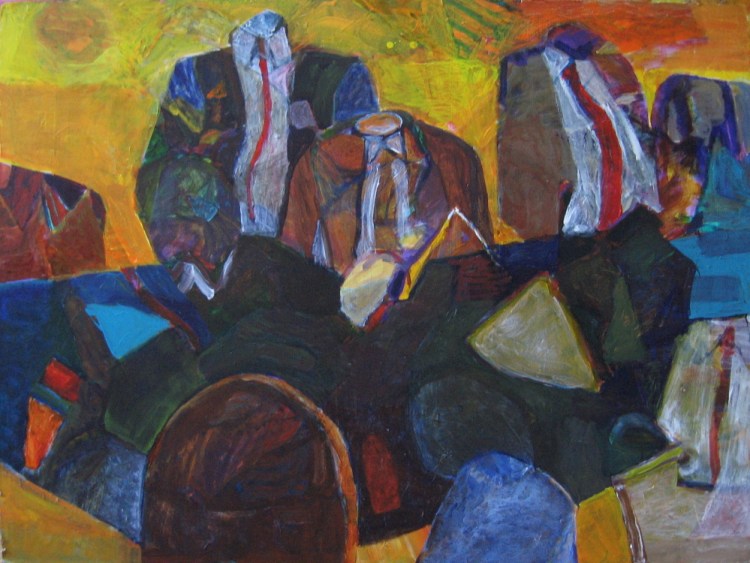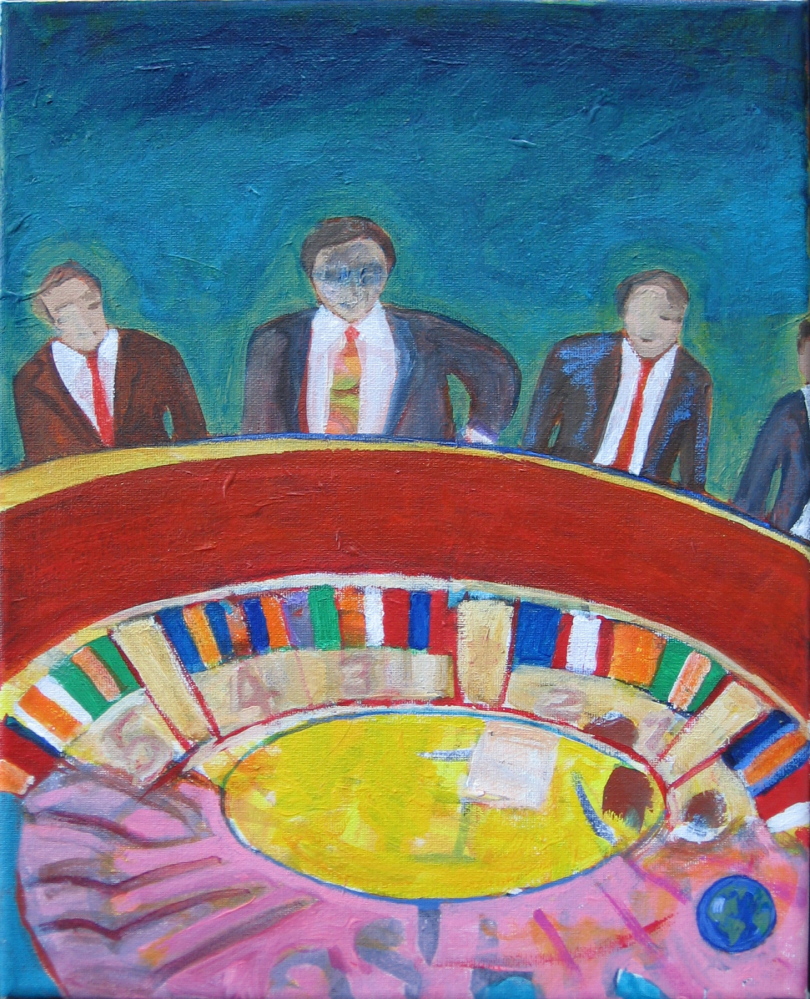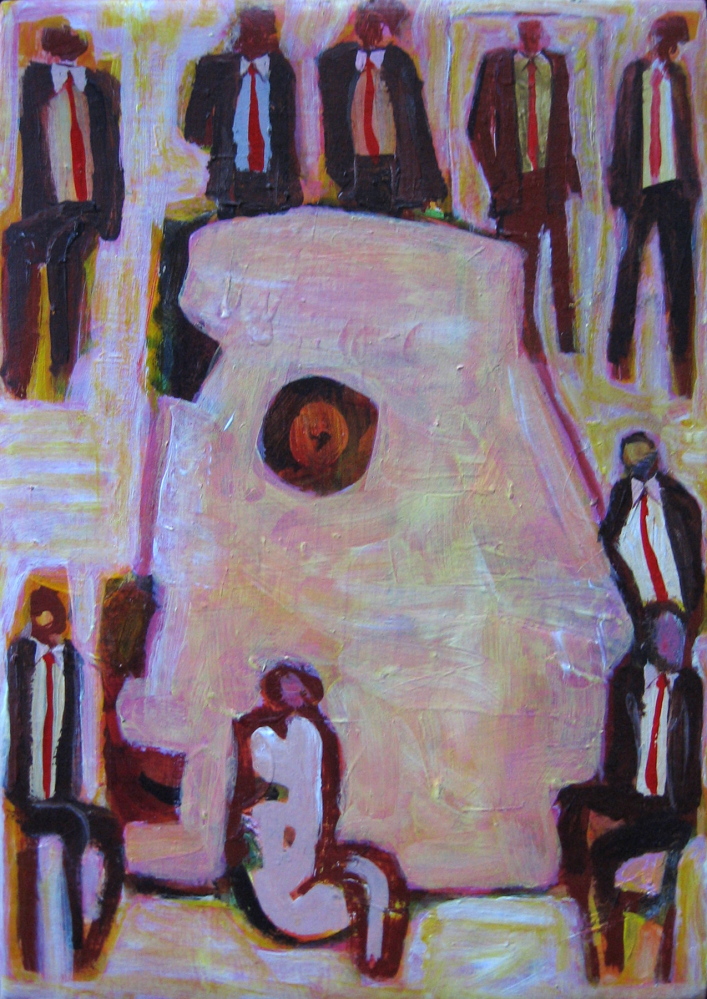One of the most difficult things to convey about Western art history is the presence of the Church. The Church was the law, philosophy, cosmology, ethics, morals and essentially the very personality of Western society. Most art and music was commissioned in the name of the Church. Crossing the Church didn’t work out for anyone – particularly artists.
The 84 works in Natasha Mayer’s exhibition at the Maine Jewish Museum, “Men in Suits,” are not about the Church. But they address a similar effect: the deep and buried relationship between culture and the ultimate seat of society’s power.
As painting, it’s an impressive surprise. As political contemporary art, it is profound, powerful and unnerving.
“Men in Suits” is something like a sweeping survey of modern and contemporary painting into which have been painted figures of dark suits with white shirts and red ties. The figures read easily enough as a view of “The Man,” in this case the financial players at the core of the collapses that led to the Great Recession.
According to Mayers: “‘Men in Suits’ materialized in my work soon after the financial crisis, when the predatory practices that wrecked the housing market and economy came to light. The people responsible were rewarded with bailouts and bonuses. I thought they needed to be exposed, so I inserted them into hundreds of postcard scenes from around the world. Now they are inhabiting my paintings, where they meet, trade, plot, swindle, gamble, and swarm.”
I had seen Mayers’ statement and some of her works. But the isolated works gave me no warning about their overwhelming impact en masse.
Mayers’ style is loose, and it’s anything but fussy or precious. Her work doesn’t translate well in photographs because it incorporates the transparent qualities of many pigments. (Transparency has been playing a growing role in Maine painting, to the point I have to wonder what’s behind it: improvements in acrylic media, maybe, or a response to artists returning to oil and acrylic after trying encaustic?)
“They Write the Rules,” for example, is a 2-foot-wide horizontal canvas that depicts three empty suits acting as though they had men in them. They are situated across from a dark and heavy form that might be a boardroom table. It’s like a scene from “Mad Men” painted by Egon Schiele – only without the men.
The image is rich and successful as a painting. The surface jumps and flickers with energy. The style is pulled taught over the entire surface. The composition reveals a well-educated sensibility that didn’t miss out on Leonardo’s lessons about pyramidal forms.
Or is that pyramid schemes?
Undoubtedly, it’s both. But neither is over-balanced and it’s an excellent painting on several easily legible levels.
The absence of actual figures from most of the suits makes the work much harder to pin down. Instead of blaming this or that specific guy, Mayers leads us to consider broader, systemic issues of our society. We all play roles, she hints. Anyone who puts on that suit is part of this issue – and anyone can put on that suit. The idea of the suit as oppressive uniform looks to real dangers both long past and recent.
When Mayers’ paintings lean toward the styles labeled “entartete kunst” (the “degenerate art” targeted by Hitler) – which is her default mode – the connections ignite.
But this is where “Men in Suits” gets complicated. Instead of a “those jerks” mentality, Mayers entreats us with wisdom along the lines of Santayana’s “Those who cannot remember the past are condemned to repeat it.” She challenges us to deconstruct our society’s power – and therefore its cultural trajectories and their underlying sources of fuel.
Yet she also challenges us not to let individuals walk free of consequences when they have committed great harm. Collective response, she hints, can also redirect systems. It’s savvy, radical and empowering ethic – and Mayers makes a compelling case that artists have the ability as well as the moral obligation to take action. She makes the case that culture can and should stand up for society.
What expands the reach of her content so unexpectedly is Mayers’ vast stylistic range. She not only elicits artists like Marsden Hartley and Anselm Kiefer, she takes them deep. Hartley appears in Mayers’ “Award Ban(k)quet,” for example, in ways that relate to his seminal “Portrait of a German Officer,” his symbolically complex “Black Horse” and his altar-esque images in memoriam of young fisherman friends lost off Nova Scotia.
In other words, these aren’t simple copies into which Mayers inserts suits: They analyze their prey with a critical eye.
Despite the heavy content, I was charmed by the paintings. Some are funny. Some are brilliant. Some are hilarious. The pulsing circuit of “Forced Arbitration,” for example, is gorgeous. The first painting, “Well-Suited Rocks,” in which the boulders of a Maine landscape adorn suits, is a genuinely impressive Keinbusch-esque Maine landscape painting. The visual swirl of “Roulette, or Everybody Knows the Game Is Rigged” features one of the most exciting compositions I have seen anywhere in a long time.
“Plutocrats Burial Ground” is a jumpy and dense cemetery painting that achieves impressive polyrhythms. “Hands Up” combines the power of Kiefer with the flayed rawness of Chaim Soutine; only instead of sides of meat, there are empty suits hanging in the slaughterhouse. “Power Couples” offers up lighthearted and echoed repeated charm, but the smile fades to discomfiture as darker implications fade into view.
What is particularly unexpected is how “Men in Suits” plays into the national fascination with zombies. This slashing dose of the uncanny somehow manages to both condemn the suit-men as insidiously dangerous and treat them with compassion – they are not in control of the destructive powers they wield so recklessly. To be a sociopath, after all, is to be sick. And to be sick is to not be yourself.
Mayers’ men in suits reveal societal sickness. But we cannot tell if they are the original pathology or merely the symptoms. They might be dangerous to us and they may cause harm, but they do not necessarily have the agency to act of their own accord. So, if we want to fix the problem, we have to probe deep into our culture.
And when you can paint as well as Natasha Mayers, digging deep isn’t out of reach. For the rest of us, it’s a call to arms: To fix the problem, we must take action. And the first step is to look deep.
Freelance writer Daniel Kany is an art historian who lives in Cumberland. He can be contacted at:
dankany@gmail.com
Copy the Story LinkSend questions/comments to the editors.





Success. Please wait for the page to reload. If the page does not reload within 5 seconds, please refresh the page.
Enter your email and password to access comments.
Hi, to comment on stories you must . This profile is in addition to your subscription and website login.
Already have a commenting profile? .
Invalid username/password.
Please check your email to confirm and complete your registration.
Only subscribers are eligible to post comments. Please subscribe or login first for digital access. Here’s why.
Use the form below to reset your password. When you've submitted your account email, we will send an email with a reset code.